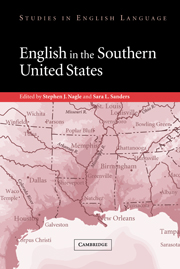Book contents
- Frontmatter
- Contents
- Notes on the contributors
- Acknowledgments
- Introduction
- 1 The origins of Southern American English
- 2 Shakespeare in the coves and hollows? Toward a history of Southern English
- 3 Eight grammatical features of southern United States speech present in early modern London prison narratives
- 4 The shared ancestry of African-American and American-White Southern Englishes: some speculations dictated by history
- 5 The complex grammatical history of African-American and white vernaculars in the South
- 6 Grammatical features of southern speech: yall, might could, and fixin to
- 7 Sounding southern: a look at the phonology of English in the South
- 8 Vowel shifting in the southern states
- 9 Enclave dialect communities in the South
- 10 Urbanization and the evolution of Southern American English
- 11 The Englishes of southern Louisiana
- 12 Features and uses of southern style
- References
- Index
7 - Sounding southern: a look at the phonology of English in the South
Published online by Cambridge University Press: 22 September 2009
- Frontmatter
- Contents
- Notes on the contributors
- Acknowledgments
- Introduction
- 1 The origins of Southern American English
- 2 Shakespeare in the coves and hollows? Toward a history of Southern English
- 3 Eight grammatical features of southern United States speech present in early modern London prison narratives
- 4 The shared ancestry of African-American and American-White Southern Englishes: some speculations dictated by history
- 5 The complex grammatical history of African-American and white vernaculars in the South
- 6 Grammatical features of southern speech: yall, might could, and fixin to
- 7 Sounding southern: a look at the phonology of English in the South
- 8 Vowel shifting in the southern states
- 9 Enclave dialect communities in the South
- 10 Urbanization and the evolution of Southern American English
- 11 The Englishes of southern Louisiana
- 12 Features and uses of southern style
- References
- Index
Summary
I know noble accents
And lucid, inescapable rhythms;
But I know, too,
That the blackbird is involved
In what I know.
(Wallace Stevens, “Thirteen Ways of Looking at a Blackbird”)Sounding southern
There is doubtless no limit to the number of ways that a blackbird may be looked at, but Wallace Stevens in his poem “Thirteen Ways of Looking at a Blackbird” demonstrates that there are at least thirteen. The same is true of Southern American English (SAE) phonology. There is really no limit to the ways of sounding southern and to the ways of describing those “noble accents,” but there are surely at least eight to explore in this look at the phonology of English in the southern United States.
Michael Montgomery's revision of James B. McMillan's Annotated Bibliography of Southern American English (McMillan and Montgomery 1989) lists over 600 items concerned in whole or in part with the phonetics or phonology of English in the South. Two inferences can be drawn from this fact. First, it is difficult to provide both a comprehensive and a detailed picture of SAE phonetics and phonology in a brief overview. However, it is possible to draw a broad picture of SAE phonology that is both understandable to the general reader and accurate in its depiction of the scene.
- Type
- Chapter
- Information
- English in the Southern United States , pp. 119 - 125Publisher: Cambridge University PressPrint publication year: 2003
- 2
- Cited by



